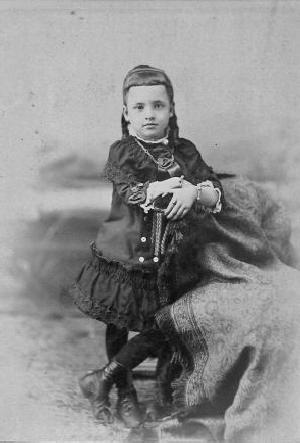
American Boy Dress Styles: Waist Treatment--Defined Waists

Figure 1.-- We think the child here is a boy because of his hair cut and stance. There is no way, however, to be sure. He has a tailored defined waist dress and long curls. v The cabinent card portrait was taken in Taylor's Falls, Minnesota at the S.C. Sargent Studio. A reader writes, "The hair does look a little strange for a girl, but there are bracelets on both wrists and a necklace. That seems like little too much jewelery for a boy." Younger boys did wear jewelry, but our reader makes a good point.
|
|
The waistline is one of the important design elements in aess. Many dresses had defined waistlines. This was the more common approach to the waist in garment design. The waisline treatment varied over time and thus can be useful in dating old photographs. The waisline treatment was done in a variety of ways. One factor was placement. Of coutse it would be commonly be placed at the waistline. But here placement varied stylistically. We have noted dresses with waislines both below and above the child's actual waisline. We note high, medium (meaning near the natural waistline), and low waistine placement. The populrity of these various approaches varied in popularity over time. One common approach was to vary the bodice above the waistline with the skirt below the waistline. Notice the dress that the child is wearing here. The waistline is far below the natural wistline and a different fabric is used for the skirt there (figure 1). This can be done in a number of ways. Some dresses are very plain and vurtully the only design elementb is the the waisline placement. Other dresses are highly decorated. Approaches included decoration like smocking on the bodice or different materials or pleating on the skirt below the waistine. The placement of the waistline also varied.
Many dresses had defined waistlines. Defined waist dresses were the most common type. Often their was waistband at the front that begane strands at the back that were tied into a bow. Presunably mother tied the bow, but we guess older girls learned to do this. Perhaps some of our readers can provide some information here. Boys wearing dresses were orobably too young to do this. A defined waist was the more common approach to the waist in dress design. The waistline treatment varied over time and thus can be useful in dating old photographs. High waislines wee an element in the empire dresses popular in the early 19th century. We notice quite a few low waistlines in the late-19th century. Medium waistlines were most common in the 20th century, especially after World War I. These trends commonly spanded national borders, in part because France or other lsrge countries significantly affected fashion trends. The waistline treatment was done in a variety of ways. One factor was placement. Of coutse it would be commonly be placed at the waistline. But here placement varied stylistically. We have noted dresses with waislines both below and above the child's actual waisline. We note high, medium (meaning near the natural waistline), and low waistine placement. The populrity of these various approaches varied in popularity over time.
Decoration Using the Waistline
One common approach was to vary the design and decioration of the bodice above the waistline with the skirt below the waistline. Some plain dresses were essentially the sanme below and above the waistline, but many dresses were donbe differently. Notice the dress that the child is wearing here (figure 1). The waistline is far below the natural waistline. In fact, it is so far below the natural waisline that the dress looks like there is no waisline. A different fabric is used for the skirt there. This can be done in a number of ways. Some dresses are very plain and virtully the only design element is the the waisline placement. Other dresses are highly decorated. Approaches included decoration like smocking on the bodice or different materials or pleating on the skirt below the waistine. The placement of the waistlinr also varied.
HBC

Navigate the Historic Boys' Clothing Web dress pages:
[Return to the Main U.S. dress waistline page]
[Return to the Main U.S. national dress style page]
[Pinafores]
[Ringlet curls]
[Smocks]
[Bodice kilts]
[Kilts]
[Fauntleroy dresses]
[Sailor dresses]
[Fancy dresses]
[Dresses: 16th-18th centuries]
[Dresses: Early-Mid-19th century]
[Dresses: Late-19th century]
[Dresses: Early 20th century]
[Difficult images]
[Movie dresses]
Navigate the Boys' Historical Clothing Web Site:
[Introduction]
[Activities]
[Biographies]
[Chronology]
[Clothing styles]
[Countries]
[Bibliographies]
[Contributions]
[Essays]
[FAQs]
[Glossaries]
[Images]
[Links]
[Registration]
[Tools]
[Boys' Clothing Home]
Created: 10:38 PM 12/9/2007
Last updated: 11:51 PM 6/23/2011



